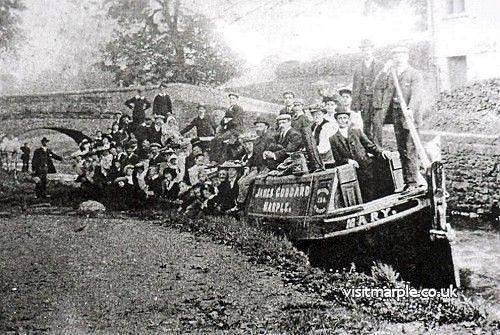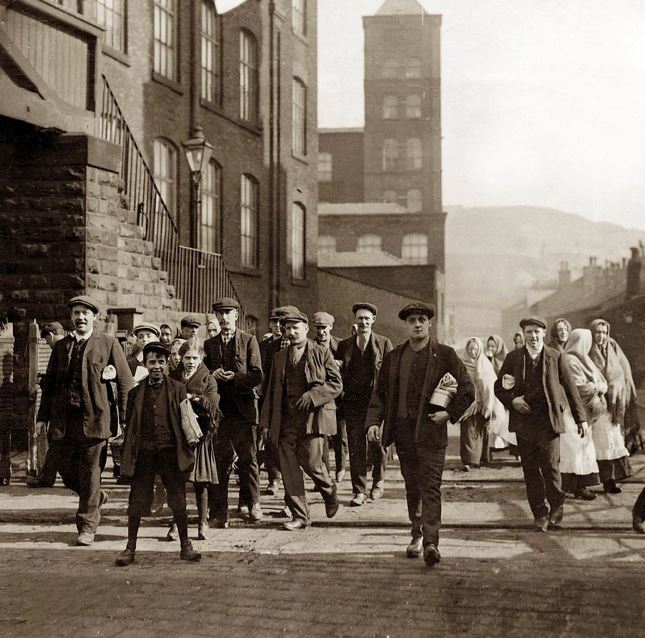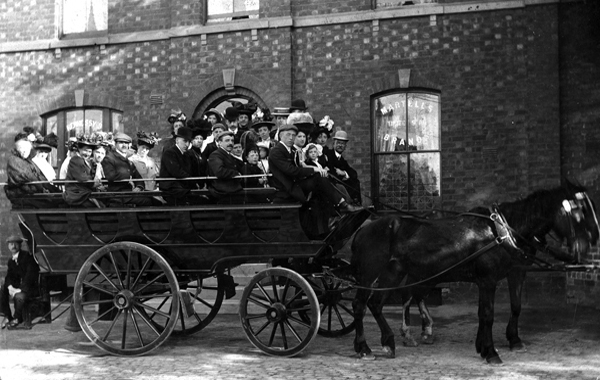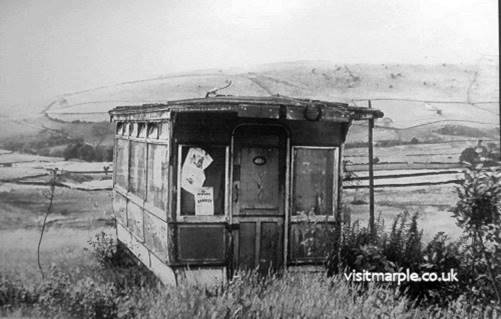
There’s no denying that life was hard in the mills. Twelve hour days and six days a week was a hard régime but it did have some lighter breaks as Anthony Burton described in his thoroughly researched talk about Marple as “a favourite and ideal holiday resort” - not Anthony’s words but a description from a contemporary newspaper. So why was “Stockport’s Vale of Tempe”1(another extravagant and somewhat fanciful comparison) the destination of choice in the late nineteenth and early twentieth century?
 Operatives leaving the mills - factory workers walking out. 1910Anthony concentrated on the period 1870 to about 1930 to analyse and explain why Marple was such an attraction. For a start, despite the working conditions, the mill workers were becoming gradually better off. By no means rich or even ‘comfortable’ but they were beginning to emerge from the grinding poverty of the early industrial revolution. One key factor was the growth and variety of transport options. Since time immemorial the only option the vast majority of people had was to walk but during the nineteenth century a succession of faster and cheaper means of transport became available.
Operatives leaving the mills - factory workers walking out. 1910Anthony concentrated on the period 1870 to about 1930 to analyse and explain why Marple was such an attraction. For a start, despite the working conditions, the mill workers were becoming gradually better off. By no means rich or even ‘comfortable’ but they were beginning to emerge from the grinding poverty of the early industrial revolution. One key factor was the growth and variety of transport options. Since time immemorial the only option the vast majority of people had was to walk but during the nineteenth century a succession of faster and cheaper means of transport became available.
"How do you fancy Marple this weekend ?"
At first Swift boats used the canals to transport passengers on specially designed boats but, despite their name, they were anything but ‘swift’ and they were quickly ousted by the railways when they came along. This revolutionary form of transport started by linking the major towns and cities but by the 1860s lines were spreading to and through even quite small towns and villages. The Marple station opened in 1865 and from then until the end of the century it saw more and more trains on regular routes as well as special excursion trains on holidays and weekends. By 1896 an incredible 106 trains were stopping at Marple each day. Throughout this sixty year period the trains brought more visitors to the Marple area than any

Trains were not the only form of mass transport. As the roads improved wagons of various designs were used to transport passengers. The most basic form was flat-bed carts called ‘lorries’ but a more comfortable version was the ‘wagonette’ which had seats built in. Trips were often organised by the precursor of our modern travel agent. Thomas Cook had established the idea of organised excursions as early as 1841 but a local firm, Dean and Dawson began in Stockport in 1871 and quickly established a national presence. By 1900 they rivalled Thomas Cook and in the Second World War their name was immortalised when it was adopted by the prisoners-of-war at Stalag Luft III for their group forging travel passes and other identity papers.
 Cycling competition at Cheadle, 1892 (No brakes...fixed wheel) click the image to see what is coming towards these gentlemen.The ultimate in transport for the individual was the bicycle. Once the first chain-driven models had been developed and the pneumatic tyre introduced the 1890s was often called the Golden Age of Bicycles but that was not really true of an area on the edge of the High Peak - there were too many hills. Instead, the motor car eventually became the vehicle of choice towards the end of the period Anthony was covering.
Cycling competition at Cheadle, 1892 (No brakes...fixed wheel) click the image to see what is coming towards these gentlemen.The ultimate in transport for the individual was the bicycle. Once the first chain-driven models had been developed and the pneumatic tyre introduced the 1890s was often called the Golden Age of Bicycles but that was not really true of an area on the edge of the High Peak - there were too many hills. Instead, the motor car eventually became the vehicle of choice towards the end of the period Anthony was covering.
So why did people come to Marple for recreation? There were two main destinations at different times. The Spring Gardens was a hostelry with a large garden with some exotic fruit trees (gooseberries.) At first just the garden was the attraction with a small entry fee which could be reclaimed by buying refreshments. By the 1850s some monkeys were added, peacocks and then an aquarium, and there were organised entertainments such as brass bands and performers. It was popular with reports of up to 2000 visitors on some Bank Holidays. The area was extended by leasing additional land from the Duke of Norfolk but in the 1880s several storms caused landslips, eating away at the area. This started a gradual decline in popularity and they closed permanently in 1914.

However, as one attraction faded another rose. When Mellor Mill burnt down in 1892 the Arkwright family decided to sell their remaining interests in the Marple area. The manager of the mill, Edwin Furness, was put in charge. A ruined mill, relying on water power and a long way from transport links was not an easy property to sell and so Furness found out. The mill pond had been used occasionally as a boating lake so with that as the kernel of a new facility he established the Roman Lakes as a recreation destination. It went from strength to strength and the new destination proved popular with families offering a variety of entertainment throughout the first half of the twentieth century. As late as 1945 10,000 people visited it in a single day.
 Weekend Chalet on Ludworth Moor click the image to see the 27 small, single storey chalets built during the interwar years. at Holtsfield, Gower Peninsula
Weekend Chalet on Ludworth Moor click the image to see the 27 small, single storey chalets built during the interwar years. at Holtsfield, Gower Peninsula
Not everyone came to be entertained. Many came to enjoy the fresh air and exercise offered by the country spaces, either as individuals or as organisations. The organisations purchased houses to give people restorative holidays. In 1891 the Manchester Working Girls charity moved into St Joseph’s Convent in Hollins Lane. In 1908 the Manchester Cathedral established their country retreat and similar arrangements were made by Ancoats School on Cheetham Hill. However, the big movement was by individuals, not organisations. Some came to walk in the hills, either alone or in groups, but most came to enjoy the country. At first they came for the day but as free time became slightly more generous they stayed overnight. A few could afford to stay in rented rooms, most could nt. They began to build shanties or shacks in open spaces, usually with but sometimes without the permission of the farmer. Over time many of these shanties became more elaborate and took on a permanence that was never anticipated at the beginning. However, the war and the town and country planning acts eventually put a stop to this. Marple’s reign as an inland holiday resort was coming to an end.
When Anthony invited questions about his novel and fascinating subject, the very first question was “Are you writing a book about this?” An indication of how much our members thought of his talk and the information he has uncovered. An embarrassed Anthony said he would and he has certainly been quick off the mark, submitting a first draft within a fortnight of being asked. We look forward to publishing the finished book.
Neil Mullineux - April 2022
Footnote:
Vale of Tempe
1Vale of Tempe, Modern Greek Témbi, narrow valley between the southern Olympus (Modern Greek: Ólympos) and northern Ossa (Kíssavos or Óssa) massifs of northeastern Thessaly (Thessalía), Greece. The valley is lined by cliffs that rise to 1,650 feet (500 m) on the south; in places it is only 90 to 165 feet (27 to 50 m) wide, and it is only about 6 miles (10 km) long.
Inspired by the lushness of its vegetation, the ancient Greeks dedicated Tempe to the cult of Apollo, who, legend says, purified himself in the waters of the Pineiós after killing the serpent Python. A temple was built in a recess on the right bank, and every eighth year a procession came from Delphi to gather sacred laurels awarded to the victors of contests.
Further Reading:
'Wakes Weeks: From the Saints to the Sea' - Elizabeth Ashworth read here
'A History of Holidays' - Tim Lambert read here

